WW1 GERMAN IMPERIAL ARMY M1917 STAHLHELM / STEEL HELMET withLiner
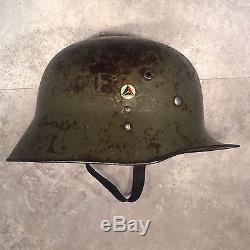
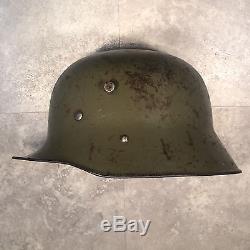
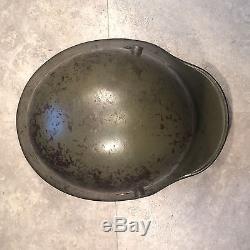
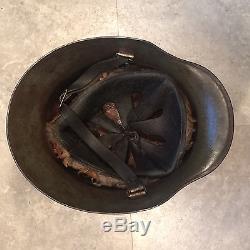
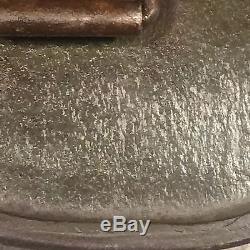
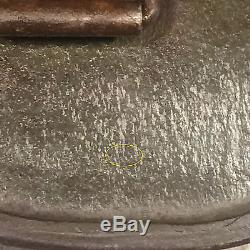
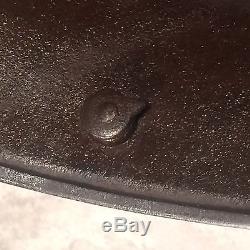

WORLD WAR 1 GERMAN IMPERIAL ARMY M1918 STAHLHELM / STEEL HELMET. The Stahlhelm (steel helmet) was introduced into regular service during the Verdun campaign in early 1916.
As WW1 drew on, it was obvious to the German army that the leather'Picklehaube', or spike helmet, offered inadequate protection for trench warfare. The German army's first official first issue steel combat helmet was the M16. The M1916 & M1918 designs had side-mounted horn-like ventilator lugs which were intended to be support for an additional steel brow plate or Stirnpanzer , which only ever saw limited use by snipers and trench raiding parties, as it was too heavy for general use.
The shell came in different sizes, from 60 to 68, with some size 70s reported. Helmet weight varied from 0.98 kg to 1.4 kg, depending on shell size. The suspension, or liner, consisted of a headband with three segmented leather pouches, each holding padding materials, and leather or fabric cords could be adjusted to provide a comfortable fit. The first model steel helmet, the M1916, used a one-piece leather chin strap that was attached to the shell by M1891 chinstrap lugs.
Same kind used on the leather Pickelhaube. Located on the "inner flaps" of the helmet. The early model of the M1918 helmet had the chinstrap attached directly to the helmet liner. Later versions of the M1918 helmet had the "ear cutouts" and are fairly rare.
The design provided excellent protection: Reserve Lieutenant Walter Schulze of 8th Company Reserve Infantry Regiment 76 described his combat introduction to the helmet on the Somme, 29 July 1916. Suddenly, with a great clanging thud, I was hit on the forehead and knocked flying onto the floor of the trench... A shrapnel bullet had hit my helmet with great violence, without piercing it, but sufficiently hard to dent it. If I had, as had been usual up until a few days previously, been wearing a cap, then the Regiment would have had one more man killed. After the effectiveness of the M1916 design was validated during the 1916 campaigns, incremental improvements were subsequently made.
The M1917 version saw improvements to the liner by the use of a steel liner band, but was otherwise identical to the original design. The liner in this helmet is very old, but I do not believe it to be the original liner. Extensive redesigns were made for the M1918 model. A new two-piece chin strap was introduced, and was attached directly to the helmet liner rather than the shell. Certain examples of the M1918 had cutouts in the rim along the sides of the helmet.
It has incorrectly been said that these cutouts were to accommodate using headphones while wearing the helmet. These cutouts were actually done to improve hearing and to reduce echo created by the large, flared skirt. The M1916 Stahlhelm can be distinguished from other models by the M1891 chinstrap attachment bolts (see photo #7) as found on the pre-war leather helmets. This helmet is in good overall shape and still retains much of its original green/loam paint scheme. There are no dents or cracks and only a light superficial rust flaking on the inside.Although very, very faint, I believe the maker/size is S. 66 which is made by.
The Frankenstein ventilator lugs on the outside of the helmet came in a few sizes and confirm the size of this helmet as 66 (large). The only size larger was the 68 and that was made by only one company. I found this helmet in Afghanistan bazaar back in 2005. You might ask, Well, how did a WW1 German Stahlhelm end up in Afghanistan? I asked myself the same thing. Following WW1, there was a lot of surplus military equipment on the market. The Afghan king, Zahir Shah, took the opportunity to modernize his forces.He bought equipment from the UK, France, Germany and even Russia. The liner of this helmet has been modified by the Afghan forces and an Afghan National Army metal badge has been attached on the right side of the helmet through a small hole (it is easily removable). Some examples of this helmet have a bronze badge with a Katyusha rocket truck; obviously belonging to rocket a rocket artillery unit.
I was told that the last service of these helmets were by the Afghan Royal Guard up to the 1970s. These helmets were used throughout WW1 by German and Austro-Hungarian forces and even saw use in WW2. The item "WW1 GERMAN IMPERIAL ARMY M1917 STAHLHELM / STEEL HELMET withLiner" is in sale since Tuesday, January 10, 2017.
This item is in the category "Collectibles\Militaria\WW I (1914-18)\Original Period Items\Germany\Hats & Helmets". The seller is "tanzer28" and is located in Windsor, Ontario. This item can be shipped worldwide.
- Country/Region of Manufacture: Germany

